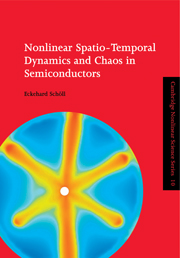Book contents
- Frontmatter
- Contents
- Preface
- Chapter 1 Semiconductors as continuous nonlinear dynamic systems
- Chapter 2 Concepts of nonlinear charge transport in semiconductors
- Chapter 3 Pattern formation and oscillatory instabilities in semiconductors
- Chapter 4 Impact-ionization-induced impurity breakdown
- Chapter 5 Nonlinear carrier dynamics in crossed electric and magnetic fields
- Chapter 6 Stationary and oscillating domains in superlattices
- Chapter 7 Spatio-temporal chaos
- References
- Index
Preface
Published online by Cambridge University Press: 17 September 2009
- Frontmatter
- Contents
- Preface
- Chapter 1 Semiconductors as continuous nonlinear dynamic systems
- Chapter 2 Concepts of nonlinear charge transport in semiconductors
- Chapter 3 Pattern formation and oscillatory instabilities in semiconductors
- Chapter 4 Impact-ionization-induced impurity breakdown
- Chapter 5 Nonlinear carrier dynamics in crossed electric and magnetic fields
- Chapter 6 Stationary and oscillating domains in superlattices
- Chapter 7 Spatio-temporal chaos
- References
- Index
Summary
More than a dozen years after my book on Nonequilibrium Phase Transitions in Semiconductors – Self-organization Induced by Generation and Recombination Processes appeared, the subject of nonlinear dynamics and pattern formation in semiconductors has become a mature field. The aim of that book had been to link two hitherto separate disciplines, semiconductor physics and nonlinear dynamics, and advance the view of a semiconductor driven far from thermodynamic equilibrium as a nonlinear dynamic system. It focussed on one particular class of instabilities related to nonlinear processes of generation and recombination of carriers in bulk semiconductors, and was essentially restricted to either purely temporal nonlinear dynamics, or nonlinear stationary spatial patterns. Within the past decade extensive research, both theoretical and experimental, has elaborated a great wealth of complex self-organized spatio-temporal patterns in various semiconductor structures and material systems. Thus semiconductors have been established as a model system with several advantages over the classical systems in which self-organization and nonlinear dynamics have been studied, viz. hydrodynamic, optical, and chemically reacting systems. First, semiconductor structures nowadays can be designed and fabricated by modern epitaxial growth technologies with almost unlimited flexibility. By controlling the vertical and lateral dimensions of those structures on an atomic length scale, systems with specific electric and optical properties can be tailored. Second, the dynamic variables describing nonlinear charge-transport properties are directly and easily accessible to measurement as electric quantities.
Information
- Type
- Chapter
- Information
- Publisher: Cambridge University PressPrint publication year: 2001
